art | architecture | design | digital | gallery | illustration | music | painting | photography | sculpture | video

The new avant-garde instrumentals by composer Jimbeau Walsh, a soundtrack for the movie of your dreams. Imagine yourself on a secluded beach in Hawaii, and, tuning into the night stars, hearing the ethereal news from afar.
Blessed Doodles - Jimbeau Walsh
Jimbeau Walsh has been a musician most of his life, and a composer for many, many years. He was a professional drummer for over 20 years and wrote his first song at age 16. An avant-garde composer, he writes in many genres and could be considered both spiritual and secular at the same time, but always modern. His latest release, "Blessed Doodles," combines his instrumental expertise and percussive grooves with beautiful and ambient melodies.
read more @ amazon »
www.roses-in-bloom.com
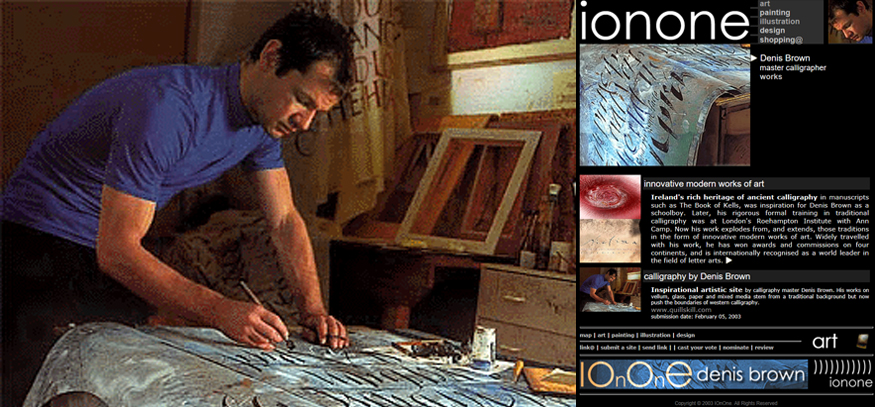
Ireland's rich heritage of ancient calligraphy in manuscripts such as The Book of Kells, was inspiration for Denis Brown as a schoolboy. Later, his rigorous formal training in traditional calligraphy was at London's Roehampton Institute with Ann Camp. Now his work explodes from, and extends, those traditions in the form of innovative modern works of art. Widely travelled with his work, he has won awards and commissions on four continents, and is internationally recognised as a world leader in the field of letter arts. read more »
www.quillskill.com
Much has happened since 2002, when Fischerspooner released their breakout record #1. If that album’s computerized fine art was a trip back to the '80s, another time warp might be necessary to sustain any momentum for Odyssey. The dance music muse, always in motion, has backed off on the electro/new wave sound that Warren Fischer and Casey Spooner used as a platform for their experimental live shows. Upon first listen, it sounds like the duo has chosen to ignore this; if Odyssey isn’t a clone of #1, it’s at least a close relation. There are, however, crucial and clever differences. The record is much friendlier for one thing, a result of warmer sonics and an unclenched pop sense that was only hinted at previously. "Just Let Go" starts off with a familiar Human League keyboard, but right in the middle of the chorus a jagged, garage band guitar riff smears the song’s makeup. Suddenly you don’t recognize them anymore. Where’s that sexy, but vacuous pose Fischer and Spooner used to lean on? There’s no pretension in a song like "A Kick in the Teeth," with its layered and lovely vocal line. Our cheese is now served straight up. The result? Tasty. - Matthew Cooke
The new wave/electro-pop troupe Fischerspooner was formed in New York City in 1998 and has come to incorporate multimedia, strange handmade costumes, dancing, and performance art. Originally a duo formed by classically trained musician Warren Fischer and video-artist and experimental theater performer Casey Spooner for an impromptu rendition of their makeshift track "Indian Cab Fever" at the Astor Place Starbucks, the group grew to over 20 performers, mostly dancers and guest vocalists. These singers have included Cindy Greene, Lizzy Yoder (also of Sweet Thunder), and Korean pop recording artist Mona Trona. The group uses the stage antics of David Bowie and traditional mainstream pop vocalists, along with the campy electronics of Giorgio Moroder or Depeche Mode and vocoders of Trans Am. By the time of their 2000 eponymous debut, Fischerspooner was a certifiable sensation in downtown New York City art galleries and clubs. The single "Emerge" topped European charts, invited a six-song remix EP, and won Fischer and Spooner invitations to international fashion, art, and society happenings. The 2002 album #1 was a re-envisioning of their debut with yet another mix of "Emerge," this time more sedate and electro, following the trend of the times. ~ Daphne Carr, All Music Guide
read more @ amazon »
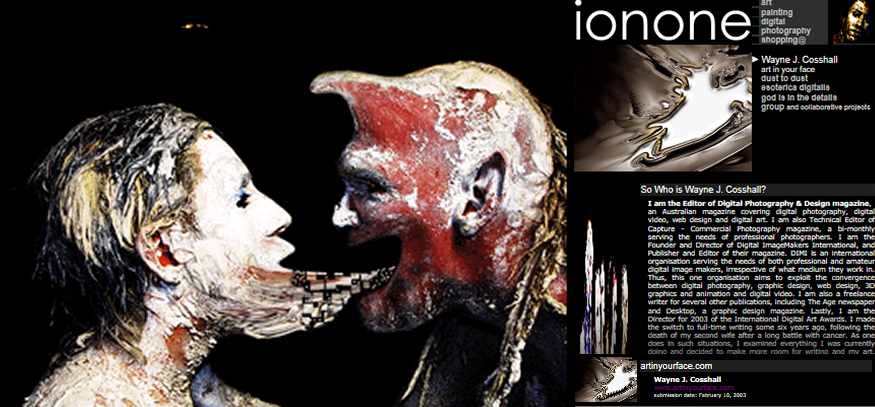
I am the Editor of Digital Photography & Design magazine,
an Australian magazine covering digital photography, digital video, web design and digital art. I am also Technical Editor of Capture - Commercial Photography magazine, a bi-monthly serving the needs of professional photographers. I am the Founder and Director of Digital ImageMakers International, and Publisher and Editor of their magazine. DIMI is an international organisation serving the needs of both professional and amateur digital image makers, irrespective of what medium they work in. Thus, this one organisation aims to exploit the convergence between digital photography, graphic design, web design, 3D graphics and animation and digital video. I am also a freelance writer for several other publications, including The Age newspaper and Desktop, a graphic design magazine. Lastly, I am the Director for 2003 of the International Digital Art Awards. I made the switch to full-time writing some six years ago, following the death of my second wife after a long battle with cancer. As one does in such situations, I examined everything I was currently doing and decided to make more room for writing and my art. Prior to this I was a Senior Lecturer in Computer Science at Swinburne University and Head of the Computer Graphics Research Group. I was an academic for 17 years there, specializing in parallel computer graphics rendering, computer architectures for graphics and mathematical and algorithmic art. I created my first computer graphics image in 1979, built my first computer in 1980 and constructed my first digital camera in 1986. Parallel to all this I was actively working on my photographic and art skills. I cut my teeth on photography as a child doing astrophotography, hooking my cameras up to the telescopes I had and built. This grew into a general interest in photography and art. I also started painting around the same time. It was during my time with my late wife that the passion for art photography and digital art really developed and I owe her a huge debt for guiding my development. I am now happily re-married and have a delightful daughter. I have exhibited my photography and digital art (predominantly mathematical and fractal imagery, up until quite recently) in group and solo shows within Australia, including invitational survey shows. My digital artwork is currently going through a period of major change and development. I also run a small graphic design and professional photography studio, with my wife and we also sell fine art materials to the local professional artists. My wife is a pastel, acrylic and oil painter (as was my late wife), and I paint in watercolours, mainly on Yupo plastic papers, as a relief from the computer work. My digital art work draws inspiration from my many interests. For my whole life I have had deep interests in, and made active studies of, philosophy, the esoteric, ancient history, esp. Egyptian, Greek, Roman and Celtic, comparative religions, mathematics, astronomy, quantum physics, paleontology, the origins of man, psychology, art and modern history, esp. European and Asian.
read more »
www.artinyourface.com

It is not my aim to create realistic reflections of my surrounding environment. I would rather like to show the things between and behind and to make my thoughts and perceptions visible. My works are frequently very strong related with personal and social conditions, experiences and emotions.
I was born in 1948 in Wiedenbrück, Germany. Since 1969 I'm married with the graphic designer Karl-Ludwig Kuhlmann. We live and work in Verl, Germany.
After leaving school in 1967 with a secondary degree I concluded a professional education as a photographer and graphic designer. At first I was an employee of Bertelsmann publishing house and worked some years in the publicity department of the Nobilia factory, a furniture and kitchens producer. Since 1976 I have been working as a freelancer for several publicity agencies and advertising departments and shaped every kind of publicity resources, like prospects, mailings, advertisements and product designs. As an example I cared for a club-journal for Radio Télé Luxemburg (RTL) for several years.
In 1994 I discovered the computer - which had been that far only a working tool, as my personal artistic medium. I gained the necessary knowledge for it in a self taught manner. Between 1994 and 2002 I extended my activities on three fields:
1. The graphic work with own photos: Digitally edited photo-collages of flowers and landscapes, frequently completed with paintings, expressing the connection between the perceptible picture and imagination. Most of them have been awarded in the annually hold Corel World Design Contest.
2. The work with 3D-programs: 3D-illustrations and landscapes in a surrealistic manner also digitally edited and supplemented with paintings.
3. Experimental and abstract works: Since beginning to use the computer as a personal artistic tool in 1994 I tended more and more towards abstraction. Especially the game with geometric forms and the research into the visual and emotional possibilities of several graphic methods are of great interest for me. i.g. to work with fractals which are always the visualized solution of a complex mathematical problem - but viewed in isolation of mathematical questions and contents they are graphic patterns as a snapshot of the infinity. Drawing by algorithmus depends widely on coincidence. However generating and selecting of dynamic forms, their editing and coloring, is based on what psychologists may call "subjective perception". Mathematical art is - although it seems to be a contradiction in terms - a very intuitive and individual kind of work.
My subjects are human relations as well as personal and social conditions. [ . ]
read more »
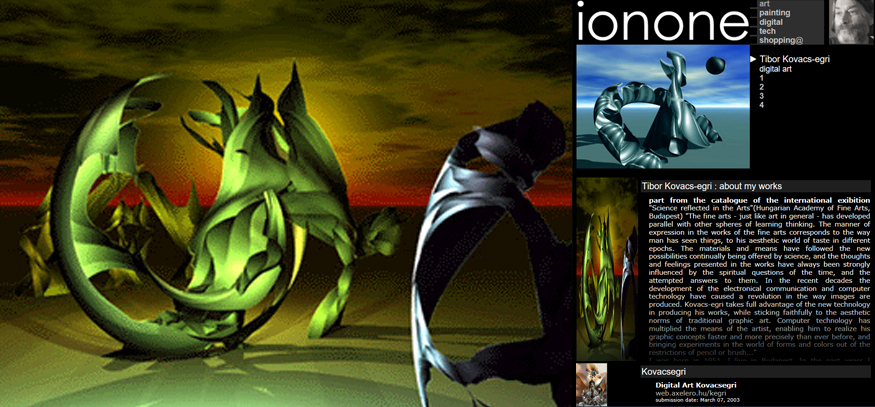
part from the catalogue of the international exibition "Science reflected in the Arts"(Hungarian Academy of Fine Arts, Budapest) "The fine arts - just like art in general - has developed parallel with other spheres of learning thinking. The manner of expression in the works of the fine arts corresponds to the way man has seen things, to his aesthetic world of taste in different epochs. The materials and means have followed the new possibilities continually being offered by science, and the thoughts and feelings presented in the works have always been strongly influenced by the spiritual questions of the time, and the attempted answers to them. In the recent decades the development of the electronical communication and computer technology have caused a revolution in the way images are produced. Kovacs-egri takes full advantage of the new technology in producing his works, while sticking faithfully to the aesthetic norms of traditional graphic art. Computer technology has multiplied the means of the artist, enabling him to realize his graphic concepts faster and more precisely than ever before, and bringing experiments in the world of forms and colors out of the restrictions of pencil or brush..."
I was born in 1951. I live in Budapest. In the past years I participated in different national and international exhibitions. My affiliation: Association of Hungarian Creative Artists.
web.axelero.hu/kegri
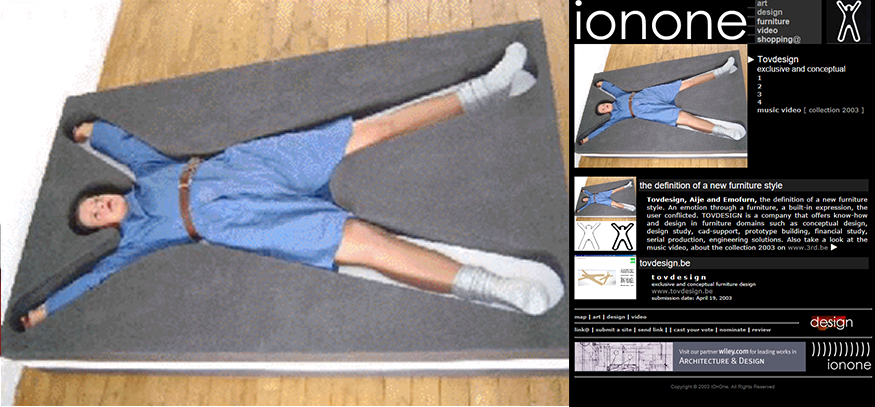
Tovdesign, Aije and Emofurn, the definition of a new furniture style. An emotion through a furniture, a built-in expression, the user conflicted. TOVDESIGN is a company that offers know-how and design in furniture domains such as conceptual design, design study, cad-support, prototype building, financial study, serial production, engineering solutions.
www.tovdesign.be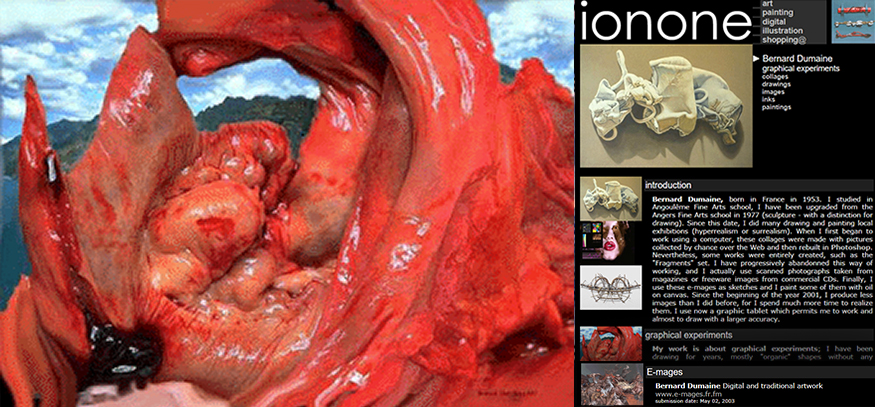
Bernard Dumaine, born in France in 1953. I studied in Angoulême Fine Arts school, I have been upgraded from the Angers Fine Arts school in 1977 (sculpture - with a distinction for drawing). Since this date, I did many drawing and painting local exhibitions (hyperrealism or surrealism). When I first began to work using a computer, these collages were made with pictures collected by chance over the Web and then rebuilt in Photoshop. Nevertheless, some works were entirely created, such as the "Fragments" set. I have progressively abandonned this way of working, and I actually use scanned photographs taken from magazines or freeware images from commercial CDs. Finally, I use these e-mages as sketches and I paint some of them with oil on canvas. Since the beginning of the year 2001, I produce less images than I did before, for I spend much more time to realize them. I use now a graphic tablet which permits me to work and almost to draw with a larger accuracy.
My work is about graphical experiments; I have been drawing for years, mostly "organic" shapes without any preliminary plan. Actually, I create pictures using Photoshop and I sometime use them as sketches to paint
www.e-mages.fr.fm
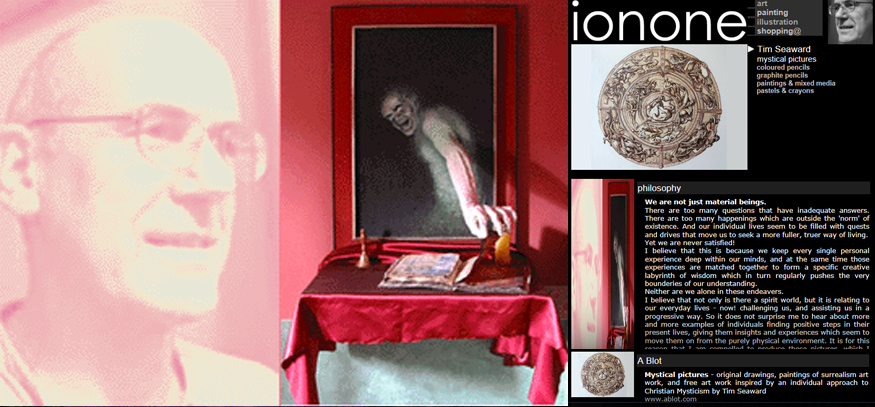
We are not just material beings. There are too many questions that have inadequate answers. There are too many happenings which are outside the 'norm' of existence. And our individual lives seem to be filled with quests and drives that move us to seek a more fuller, truer way of living. Yet we are never satisfied! I believe that this is because we keep every single personal experience deep within our minds, and at the same time those experiences are matched together to form a specific creative labyrinth of wisdom which in turn regularly pushes the very bounderies of our understanding. Neither are we alone in these endeavers. I believe that not only is there a spirit world, but it is relating to our everyday lives - now! challenging us, and assisting us in a progressive way. So it does not surprise me to hear about more and more examples of individuals finding positive steps in their present lives, giving them insights and experiences which seem to move them on from the purely physical environment. It is for this reason that I am compelled to produce these pictures, which I believe are simple but relevant aids to be observed and remembered. More specifically, I feel that once the picture is seen, then the mind stores the image - permanently. The visual, being an indelible element, will be unravelled at the appropriate time. I liken this 'process' to the ancient form of chemistry - Alchemy, inwhich the alchemist was driven by the thought that gold could be made from base metals and that there was a material called the philosophers stone which was a vital ingredient to producing the elixir of life. These pictures are my attempt at being a metaphoric alchemist! read more »
www.ablot.com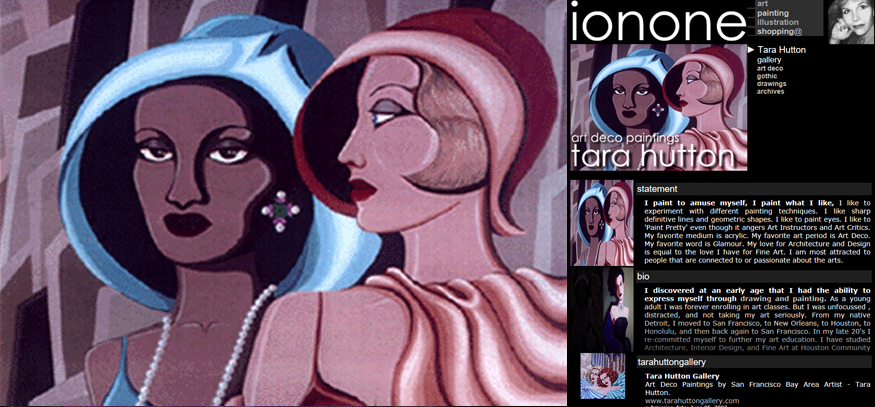
I paint to amuse myself, I paint what I like, I like to experiment with different painting techniques. I like sharp definitive lines and geometric shapes. I like to paint eyes. I like to 'Paint Pretty' even though it angers Art Instructors and Art Critics. My favorite medium is acrylic. My favorite art period is Art Deco. My favorite word is Glamour. My love for Architecture and Design is equal to the love I have for Fine Art. I am most attracted to people that are connected to or passionate about the arts.
I discovered at an early age that I had the ability to express myself through drawing and painting. As a young adult I was forever enrolling in art classes. But I was unfocussed , distracted, and not taking my art seriously. From my native Detroit, I moved to San Francisco, to New Orleans, to Houston, to Honolulu, and then back again to San Francisco. In my late 20's I re-committed myself to further my art education. I have studied Architecture, Interior Design, and Fine Art at Houston Community College in Texas and also at the College of Marin in California. It was at the College of Marin that I took my first figurative painting class and I heard my calling, I have been at the easel ever since.
read more »
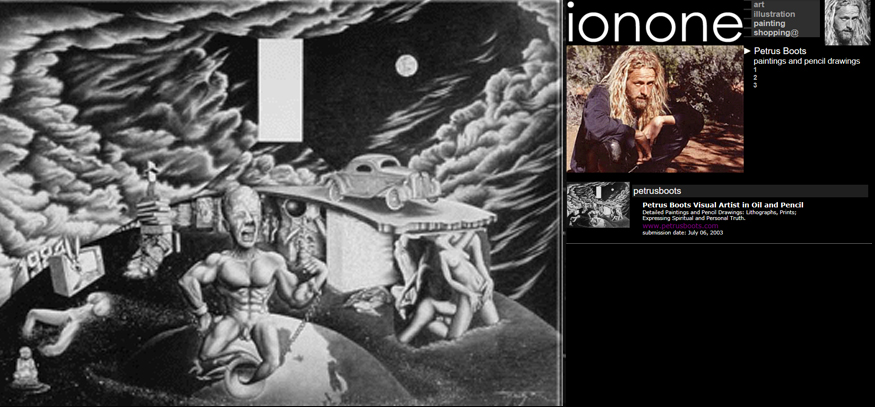
Detailed Paintings and Pencil Drawings: Lithographs, Prints; Expressing Spiritual and Personal Truth. read more »
www.petrusboots.com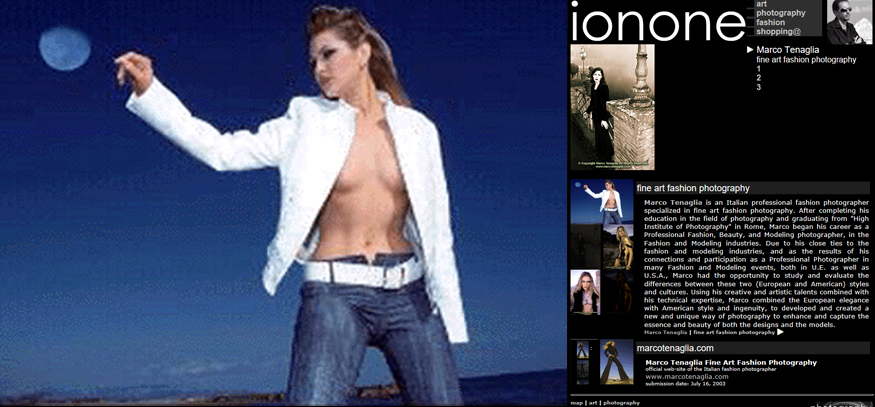
Marco Tenaglia is an Italian professional fashion photographer specialized in fine art fashion photography. After completing his education in the field of photography and graduating from "High Institute of Photography" in Rome, Marco began his career as a Professional Fashion, Beauty, and Modeling photographer, in the Fashion and Modeling industries. Due to his close ties to the fashion and modeling industries, and as the results of his connections and participation as a Professional Photographer in many Fashion and Modeling events, both in U.E. as well as U.S.A., Marco had the opportunity to study and evaluate the differences between these two (European and American) styles and cultures. Using his creative and artistic talents combined with his technical expertise, Marco combined the European elegance with American style and ingenuity, to developed and created a new and unique way of photography to enhance and capture the essence and beauty of both the designs and the models.
read more »
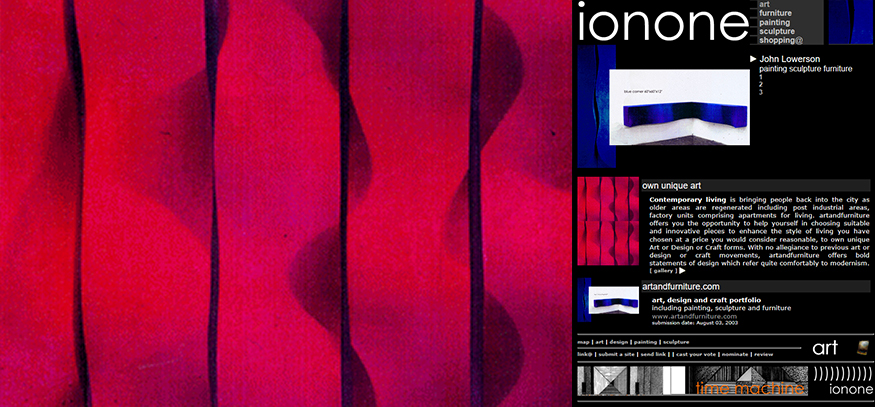
Contemporary living is bringing people back into the city as older areas are regenerated including post industrial areas, factory units comprising apartments for living. artandfurniture offers you the opportunity to help yourself in choosing suitable and innovative pieces to enhance the style of living you have chosen at a price you would consider reasonable, to own unique Art or Design or Craft forms. With no allegiance to previous art or design or craft movements, artandfurniture offers bold statements of design which refer quite comfortably to modernism.
artandfurniture.com
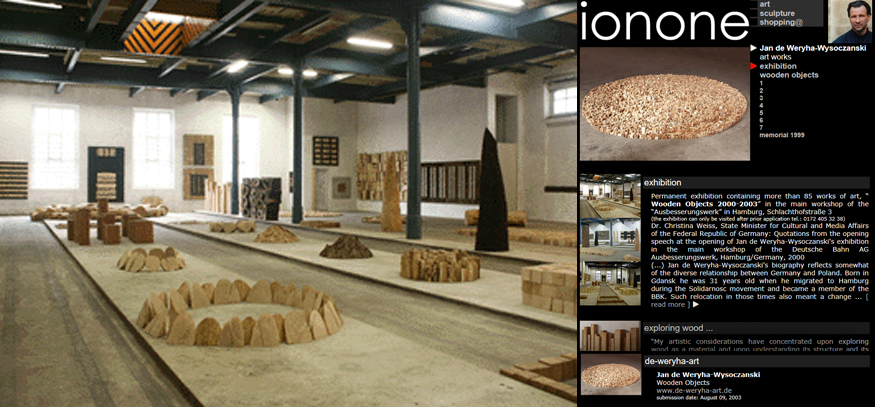
Permanent exhibition containing more than 85 works of art, “ Wooden Objects 2000-2003” in the main workshop of the “Ausbesserungswerk” in Hamburg, Schlachthofstraße 3
(the exhibition can only be visited after prior application tel.: 0172 405 32 38)
(...) Jan de Weryha-Wysoczanski's biography reflects somewhat of the diverse relationship between Germany and Poland. Born in Gdansk he was 31 years old when he migrated to Hamburg during the Solidarnosc movement and became a member of the BBK. Such relocation in those times also meant a change from one political system to another, from one ideology to the opposing and, therefore, may leave its mark on the person and artist. Artistically, the committing influence of the American Minimal Art is obvious, especially Carl Andre's early sculptures from the sixties. The relationship of thinking creatively makes both artists associates. Carl Andre thinks structural and consequently endeavors the repatriation to primary structures. He wants to depart from the forms invented by artists, especially from the compositional hierarchy and artistically individual touch. Or, as Sol LeWitt put it: "The form itself is of very limited meaning, it becomes the grammar of the total work." At first sight you tend to describe Jan de Weryha as a late European representative of the Minimal Art. But as soon as you take a closer look it gets clear that Jan de Weryha has demands which are extremely contrary to the Minimal Art. His creative activity is mainly focused on the nature and the natural structure of the material. With his works the natural basis meets the rational will of designing. He again admits the pure form of the Minimal Art in double respects. For example, instead of avoiding the individual processing traces of the wood through industrial production he completely puts it to the center of attention. Power saws, axes and firmer chisels leave completely different surfaces. Furthermore, he loves to align his quite minimal formations willfully to basic patterns of the nature such as anthills, beehives or archaic constructions: igloo, column, tower, or simple stacks as for drying wood can be found again and again. With Jan de Weryha's works the nature and the natural structure of the material form the starting point for his designs and creative processes. His works exist on the confrontation of the sculptured and raw, the touched and unaffected. At the same time he consciously disappoints the viewer's expectation, who is used to prefer processed sides of a sculpture compared to the supposedly unworked side. Ladies and Gentlemen: Processes of historic dimensions such as the European integration and the planned eastern expansion of the EU require the ability to communicate to a great extent, willingness to work on current problems and historic burdens but also future chances - all together and creatively. Due to their willingness, the culture, the art and the artists have always developed instruments to experiment, to exceed limits, to question the conventional, to develop instruments which may have model character when collaborating with others. And they have developed a language leaving all limits behind. In this context, the exhibition we are opening today is a living sign. Because Jan de Weryha-Wysoczanski is a German-Polish artist in whose work the history and tradition of our both countries took influence. And those, who want to understand the exhibition, do not have to be able to speak German or Polish. They must only get involved in seeing.
“My artistic considerations have concentrated upon exploring wood as a material and upon understanding its structure and its core. The question, to which extent is it legitimate to influence the material by means of intervention without interfering with its identity, has accompanied my work and will continue to accompany my work.”
read more »
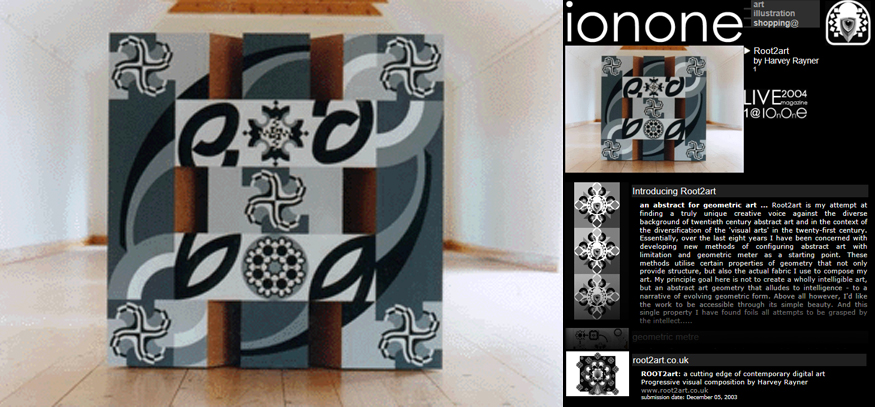
an abstract for geometric art ... Root2art is my attempt at finding a truly unique creative voice against the diverse background of twentieth century abstract art and in the context of the diversification of the 'visual arts' in the twenty-first century. Essentially, over the last eight years I have been concerned with developing new methods of configuring abstract art with limitation and geometric meter as a starting point. These methods utilise certain properties of geometry that not only provide structure, but also the actual fabric I use to compose my art. My principle goal here is not to create a wholly intelligible art, but an abstract art geometry that alludes to intelligence - to a narrative of evolving geometric form. Above all however, I'd like the work to be accessible through its simple beauty. And this single property I have found foils all attempts to be grasped by the intellect.....
I describe my work as being created in and derived from a unique system of geometric metre. This is the metre of visual composition as opposed to the metre found in poetry although the formalising and ordering property is the same. This metre, derived from particular and distinct geometry, provides a grammar and the fabric of my visual language.
I liken this system to the structural conventions evolved and adhered to in musical composition. These conventions limit, define and order an abstract sound world into the stuff of musical language. As with some musical language my visual language is shaped by the concerns of harmony, dynamics, rhythm, lyricism and counterpoint. I find music, and musical terminology an invaluable resource in describing my work and finding tangible ideas for invention within visual composition.
read more »